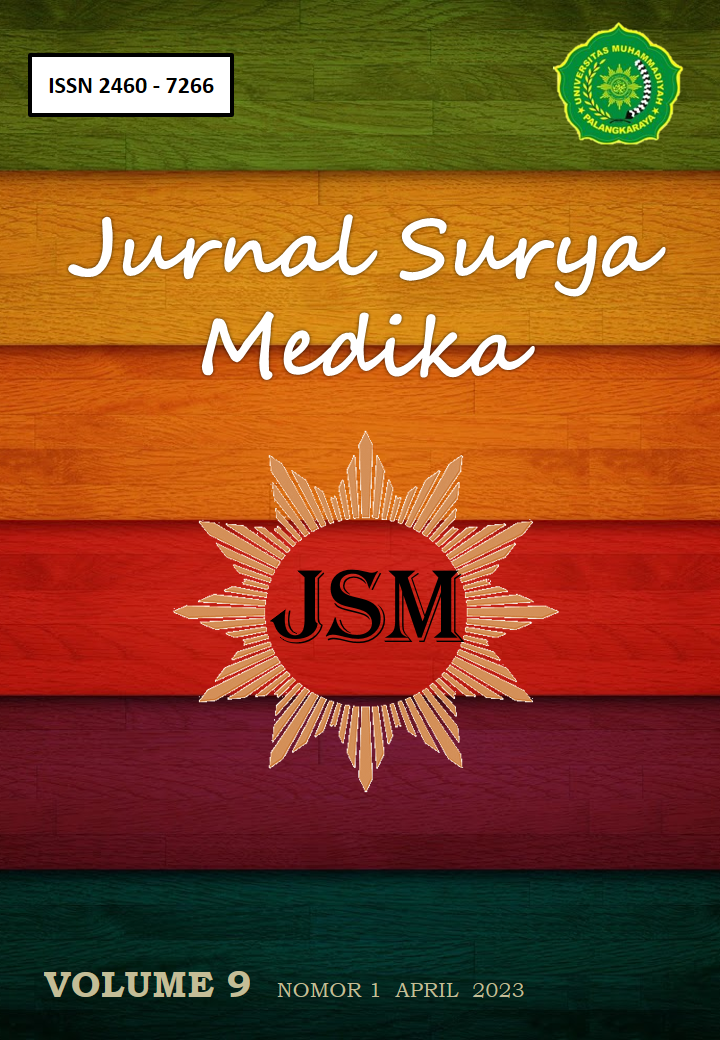Autentikasi Bunga R.tomentosa dari Resiko Adulterasi M. Candidum dengan Metode Spektrofotometri UV-VIS Kombinasi Khemmometrik Authentication of R.tomentosa Flowers From the Risk of M. Candidum Adulteration Using Chemometric Combination UV-VIS Spectrophotometry Method
Main Article Content
Abstract
R. tomentosa flowers have various activities and these activities are different from M. candidum flowers, but have similar flowers so the risk of mixing is very high. Therefore, this study aims to prevent the occurrence of mixtures using UV-VIS spectrophotometry method combined with chemometrics. The method used in this study was the extracts of the two species were dissolved with methanol p.a and scanned the spectra at a wavelength of 200-400 nm, data analysis using partial least squares. The results obtained in the authentication of Bunga R.tomentosa produced various models, at 248.14-222.5 nm scanning resulted in data RMSEC: 2.61, R2: 0.9971, RMSEP:5.78, R2: 0.9951 and RMSECV:9.19, R2: 0.9655, On scanning 298.43- 56.36nm produces data RMSEC:0.929, R2: 0.9996, RMSEP:3.54, R2: 0.9956 and RMSECV:10.5,R2:0.9591, by looking at the two data, the lowest RMSE value and the highest R2 value are selected. The conclusion in this study is that the best model for R.tomentosa authentication is the second derivatization with a wavelength of 298.43-256.36nm.
Downloads
Article Details

This work is licensed under a Creative Commons Attribution-ShareAlike 4.0 International License.
All rights reserved. This publication may be reproduced, stored in a retrieval system, or transmitted in any form or by any means, electronic, mechanical, photocopying, recording.
References
BPOM RI. 2013. Petunjuk Operasional Penerapan Pedoman Cara Pembuatan Obat yang Baik 2012. Badan Pengawas Obat dan Makanan, Jakarta.
Brereton, R. G. 2000. Introduction to multivariate calibration in analytical chemistry. Analyst, 125(11), 2125–2154. https://doi.org/10.1039/B003805I
Chorachoo, J., Lambert, S., Furnholm, T., Roberts, L., Reingold, L., Auepemkiate, S., Voravuthikunchai, S. P., & Johnston, A. 2018. The small molecule rhodomyrtone suppresses TNF-α and IL-17A-induced keratinocyte inflammatory responses: A potential new therapeutic for psoriasis. PloS One, 13(10), e0205340.
Chuakul, W. 2005. Medicinal plants in the Khok Pho district, pattani province (Thailand).
Do, T. L. 1991. Medicinal plants and herbal remedies of Vietnam. Science and Technique, Hanoi, 907–908.
Handoko, L. T. 2020. Potensi Keanekaragaman Hayati Indonesia untuk Bioprospeksi dan Bioekonomi | Lembaga Ilmu Pengetahuan Indonesia. In Lipi. http://lipi.go.id/berita/Potensi-Keanekaragaman-Hayati-Indonesia-untuk-Bioprospeksi-dan-Bioekonomi/22154
Jeong, D., Yang, W. S., Yang, Y., Nam, G., Kim, J. H., Yoon, D. H., Noh, H. J., Lee, S., Kim, T. W., & Sung, G.-H. 2013. In vitro and in vivo anti-inflammatory effect of Rhodomyrtus tomentosa methanol extract. Journal of Ethnopharmacology, 146(1), 205–213.
Lee, M. H., Lin, R. D., Shen, L. Y., Yang, L. L., Yen, K. Y., & Hou, W. C. 2001. Monoamine oxidase B and free radical scavenging activities of natural flavonoids in Melastoma candidum D. Don. Journal of Agricultural and Food Chemistry, 49(11), 5551–5555. https://doi.org/10.1021/jf010622j
Lim, T. K. 2012. Edible medicinal and non-medicinal plants (Vol. 1). Springer.
Lowry, J. B. 1976. Anthocyanins of the Melastomataceae, Myrtaceae and some allied families. Phytochemistry, 15(4), 513–516.
Maggio, R., Kaufman, T., Del Carlo, M., Cerretani, L., Bendini, A., Cichelli, A., & Compagnone, D. 2013. Monitoring of fatty acid composition in virgin olive oil by Fourier transformed infrared spectroscopy with partial least squares. Food Chemistry, 1549–1554. https://doi.org/10.1016/j.foodchem.2008.11.029
Na-Phatthalung, P., Teles, M., Voravuthikunchai, S. P., Tort, L., & Fierro-Castro, C. 2018. Immunomodulatory effects of Rhodomyrtus tomentosa leaf extract and its derivative compound, rhodomyrtone, on head kidney macrophages of rainbow trout (Oncorhynchus mykiss). Fish Physiology and Biochemistry, 44(2), 543–555.
Ong, H. C., & Nordiana, M. 1999. Malay ethno-medico botany in Machang, Kelantan, Malaysia. Fitoterapia, 70(5), 502–513. https://doi.org/https://doi.org/10.1016/S0367-326X(99)00077-5
Pataki, L., Zapp, E., Belcher, R., Betteridge, D., & Meites, L. 2013. Basic Analytical Chemistry. Elsevier Science. https://books.google.co.id/books?id=QjoXBQAAQBAJ
Patnaik, P. 2004. Dean’s Analytical Chemistry Handbook. McGraw-Hill Education. https://books.google.co.id/books?id=lSiGBA9ij-QC
Rafi, M., W, N. S., Wahyuni, W. T., Arif, Z., & Heryanto, R. 2021. Autentikasi Kumis Kucing (Orthosiphon Aristatus) Menggunakan Kombinasi Spektrum Ultraviolet-Tampak Dan Partial Least Square Regression. Indonesian Journal of Chemometrics and Pharmaceutical Analysis, 1(2 SE-Original Articles). https://doi.org/10.22146/ijcpa.890
Riza Marjoni, M., & A, Z. 2017. Antioxidant Activity of Methanol Extract/Fractions of Senggani Leaves (Melastoma candidum D. Don). Pharmaceutica Analytica Acta, 08. https://doi.org/10.4172/2153-2435.1000557
Rohman, A., & Che Man, Y. B. 2011. Application of Fourier transform infrared (FT-IR) spectroscopy combined with chemometrics for authentication of cod-liver oil. Vibrational Spectroscopy, 55(2), 141–145. https://doi.org/https://doi.org/10.1016/j.vibspec.2010.10.001
Shiratake, S., Nakahara, T., Iwahashi, H., Onodera, T., & Mizushina, Y. 2015. Rose myrtle (Rhodomyrtus tomentosa) extract and its component, piceatannol, enhance the activity of DNA polymerase and suppress the inflammatory response elicited by UVB‑induced DNA damage in skin cells. Molecular Medicine Reports, 12(4), 5857–5864.
Srisuwan, S., Tongtawe, P., Srimanote, P., & Voravuthikunchai, S. P. 2014. Rhodomyrtone modulates innate immune responses of THP-1 monocytes to assist in clearing methicillin-resistant Staphylococcus aureus. PloS One, 9(10), e110321.
Van Breemen, R. B., Fong, H. H. S., & Farnsworth, N. R. 2007. The role of quality assurance and standardization in the safety of botanical dietary supplements. Chemical Research in Toxicology, 20(4), 577–582. https://doi.org/10.1021/tx7000493
Wang, Y.-C., Hsu, H.-W., & Liao, W.-L. 2008. Antibacterial activity of Melastoma candidum D. Don. LWT - Food Science and Technology, 41, 1793–1798. https://doi.org/10.1016/j.lwt.2008.02.005
Williams, T. R. 1963. Handbook of analytical chemistry (Meites, Louis). Journal of Chemical Education, 40(10), 560. https://doi.org/10.1021/ed040p560.1
Wypych, G. 2015. Handbook of UV Degradation and Stabilization. Elsevier Science. https://books.google.co.id/books?id=Kb3uBQAAQBAJ
